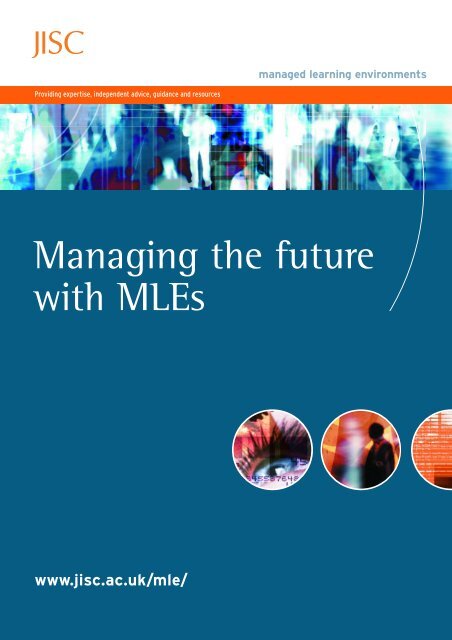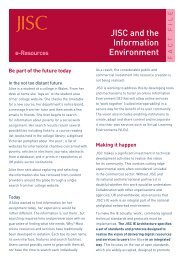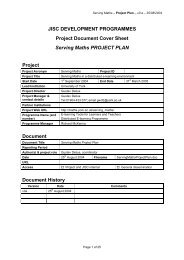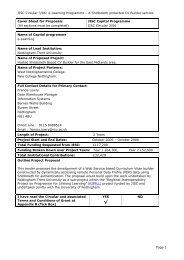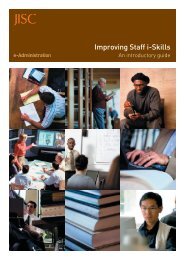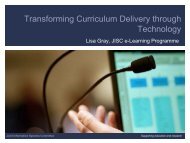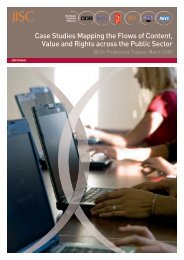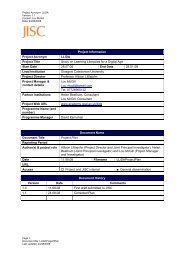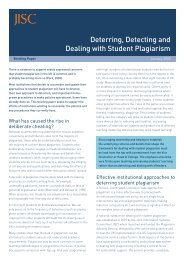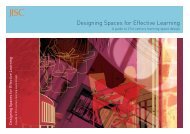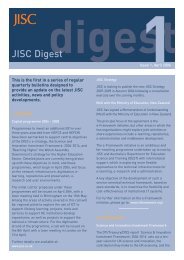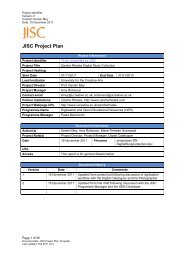Managing the future with MLEs - Jisc
Managing the future with MLEs - Jisc
Managing the future with MLEs - Jisc
You also want an ePaper? Increase the reach of your titles
YUMPU automatically turns print PDFs into web optimized ePapers that Google loves.
managed learning environments<br />
Providing expertise, independent advice, guidance and resources<br />
<strong>Managing</strong> <strong>the</strong> <strong>future</strong><br />
<strong>with</strong> <strong>MLEs</strong><br />
www.jisc.ac.uk/mle/
<strong>Managing</strong> <strong>the</strong> <strong>future</strong> <strong>with</strong> <strong>MLEs</strong><br />
MLE: a new era of possibilities 1<br />
1. Executive Summary 2<br />
2 Context 4<br />
2.1 National climate 4<br />
2.2 Technology context 5<br />
2.3 College environment 5<br />
2.4 Vendors’ environment 6<br />
3 Programme of activity 7<br />
3.1 Awareness-raising 7<br />
3.2 Interoperability pilots 8<br />
4 Conclusions 12<br />
4.1 Culture 12<br />
4.2 Standards 12<br />
4.3 Support 13<br />
5 Recommendations 14<br />
5.1 to colleges 14<br />
5.2 to <strong>the</strong> Learning and Skills Council 14<br />
5.3 to <strong>the</strong> JISC 15<br />
5.4 to vendors 16
<strong>Managing</strong> <strong>the</strong> <strong>future</strong> <strong>with</strong> <strong>MLEs</strong><br />
MLE: A new era of possibilities<br />
FE colleges operate in an increasingly demanding environment. Colleges<br />
need to juggle <strong>the</strong> realities of increased competition and heightened quality<br />
expectations at a time of reduced real-term funding. Only through change can<br />
<strong>the</strong>y succeed.Technology may provide a solution – through Managed Learning<br />
Environments (<strong>MLEs</strong>).<br />
MLE thinking is about college processes and standards, not software products.<br />
It provides a framework <strong>with</strong>in which choices about software, training and above<br />
all support for learners and tutors can be made and an MLE offers massive<br />
potential for colleges to satisfy demands for anywhere, anytime learning.<br />
Colleges need to overcome two hurdles. The first is cultural.All college staff will<br />
need to work toge<strong>the</strong>r to achieve new pedagogic models and <strong>the</strong> most appropriate<br />
Information and Learning Technology (ILT) strategies. Genuine flexibility and<br />
higher levels of efficiency are dependent on <strong>the</strong> seamless operation of college<br />
systems. Full integration of <strong>the</strong> systems that underpin learning is <strong>the</strong> second<br />
hurdle and a satisfactory solution is most likely to come from a standards or<br />
specifications based approach. Overcoming technical obstacles is a major<br />
undertaking that requires <strong>the</strong> close collaboration of <strong>the</strong> entire community of<br />
colleges, support agencies and suppliers.<br />
These are <strong>the</strong> key issues that face <strong>the</strong> FE community today. This report offers<br />
broad conclusions and recommendations to four main stakeholders – colleges, <strong>the</strong><br />
Learning and Skills Council (LSC), <strong>the</strong> JISC and vendors – at a time when<br />
e-learning i is seen as increasingly important.<br />
MLE thinking is about<br />
college processes and<br />
standards, not software<br />
products. It provides a<br />
framework <strong>with</strong>in which<br />
choices about software,<br />
training and above all<br />
support for learners and<br />
tutors can be made<br />
i Announcement from <strong>the</strong> Department for Education and Skills Post 16 e-Learning Task Group<br />
http://www.dfes.gov.uk/elearningstrategy/news.cfm?aID=86<br />
1
1. Executive Summary<br />
Colleges are operating in a fast-changing and challenging environment.The<br />
sector is gradually trying to move towards a greater focus on customer needs and<br />
<strong>the</strong> JISC believes that Managed Learning Environments can help colleges to better<br />
support <strong>the</strong>ir learners.<br />
Through its MLE Steering Group, <strong>the</strong> JISC has established key terms that<br />
explain how e-learning systems can fit toge<strong>the</strong>r.<br />
• The term Virtual Learning Environment (VLE) refers to <strong>the</strong> component(s) <strong>with</strong>in<br />
an MLE that provides <strong>the</strong> “online” interactions of various kinds which can take<br />
place between learners and tutors, including online learning<br />
• The term Managed Learning Environment (MLE) refers to <strong>the</strong> whole range of<br />
information systems and processes of a college (including its VLE if it has one)<br />
that contribute directly, or indirectly, to learning and <strong>the</strong> management of that<br />
learning<br />
An interoperability studies programme was established in English FE colleges to<br />
investigate <strong>the</strong> feasibility of using a building blocks approach to <strong>the</strong> creation of an<br />
MLE. The IMS specifications were used to help link toge<strong>the</strong>r Virtual Learning<br />
Environments (which deliver and track online learning) <strong>with</strong> <strong>the</strong> Student Records<br />
System and make steps towards a full college MLE. This work demonstrates <strong>the</strong><br />
importance of taking a standards- or specifications- based approach. Full details of<br />
<strong>the</strong>se interoperability studies are available in <strong>the</strong> separate MLESG Technical<br />
Report ii .<br />
Key conclusions from <strong>the</strong> work of <strong>the</strong> MLESG include:<br />
• Successful implementation of <strong>MLEs</strong> will require organisational culture change<br />
and re-engineering of business processes <strong>with</strong>in colleges, <strong>with</strong> substantial staff<br />
training to ensure <strong>the</strong>y effectively integrate e-learning into college business<br />
• Standards have to be adopted as <strong>the</strong> basis for interoperability of systems <strong>with</strong>in<br />
college <strong>MLEs</strong>, and between colleges and <strong>the</strong> LSC. IMS is generally considered to<br />
offer <strong>the</strong> best framework<br />
• Colleges will need support and information from central bodies to help <strong>the</strong>m<br />
plan <strong>the</strong> development of <strong>the</strong>ir <strong>MLEs</strong>. The JISC and <strong>the</strong> LSC will have a key role in<br />
setting <strong>the</strong> framework for a coherent interoperability agenda to guide <strong>the</strong><br />
contributions of agencies, advisory services and vendors<br />
• Commercial vendors have played an essential role in developing <strong>the</strong>ir products<br />
to be interoperable <strong>with</strong> o<strong>the</strong>r systems. The JISC and o<strong>the</strong>rs need to support this<br />
role in <strong>future</strong> work.<br />
The JISC and <strong>the</strong> LSC will<br />
have a key role in setting<br />
<strong>the</strong> framework for a<br />
coherent interoperability<br />
agenda to guide <strong>the</strong><br />
contributions of agencies,<br />
advisory services and<br />
vendors<br />
ii The Managed Learning Environments Steering Group Technical Report: A report on <strong>the</strong> Interoperability Pilot programme,<br />
JISC: 2002<br />
2
<strong>Managing</strong> <strong>the</strong> <strong>future</strong> <strong>with</strong> <strong>MLEs</strong><br />
Successful implementation<br />
of <strong>MLEs</strong> will require<br />
organisational culture<br />
change and re-engineering<br />
of business processes<br />
<strong>with</strong>in colleges<br />
Reproduced by kind permission of BECTa<br />
What does a VLE do?<br />
As outlined in MLESG Briefing Paper 1 iii , <strong>the</strong> principle functions that <strong>the</strong><br />
complete VLE needs to deliver are:<br />
• Controlled access to a curriculum that has been mapped to elements (or<br />
‘chunks’) that can be separately assessed and recorded<br />
• Tracking of student activity and achievement against <strong>the</strong>se elements to allow<br />
tutors to set up a course <strong>with</strong> materials and activities to direct, guide and<br />
monitor learner progress<br />
• Support of online learning, including access to learning resources, assessment<br />
and guidance. The learning resources may be self-developed, professionally<br />
authored or purchased materials<br />
• Communication between <strong>the</strong> learner, <strong>the</strong> tutor and o<strong>the</strong>r specialists to provide<br />
support and feedback for learners, as well as peer-group communications that<br />
build a sense of group identity and community of interest<br />
• Links to o<strong>the</strong>r administrative systems, both in-house and externally<br />
iii <strong>MLEs</strong> and VLEs Explained MLE Briefing Paper 1 in JISC MLE Information Pack<br />
http://www.jisc.ac.uk/mle/reps/briefings/bp1.html<br />
3
2. Context<br />
The use of Information and Learning Technology (ILT) across <strong>the</strong> English FE sector,<br />
as originally conceptualised by <strong>the</strong> Fur<strong>the</strong>r Education Funding Council’s (FEFC’s)<br />
Higginson Committee iv , established a view that IT would enhance all aspects of<br />
college services and systems <strong>with</strong> benefits for <strong>the</strong> extended community of learners.<br />
MLE thinking represents a systematic view of how a number of IT components,<br />
such as a VLE or a Student Record System (SRS), might interact <strong>with</strong> college<br />
processes to support a more flexible learning environment. The work reported here<br />
and in <strong>the</strong> separate MLESG Technical Report reflects <strong>the</strong> importance of <strong>the</strong> MLE<br />
programmes at <strong>the</strong> core of <strong>the</strong> Joint Information Systems Committee (JISC) Five<br />
Year Strategy v in developing MLE awareness and implementation across <strong>the</strong> whole<br />
of <strong>the</strong> UK, in FE and HE.<br />
2.1 National climate<br />
The government sees e-learning as a major development area for all learning<br />
and skills sectors. This is demonstrated through <strong>the</strong> University for Industry (UfI),<br />
National Grid for Learning (NGfL), National Learning Network (NLN) and o<strong>the</strong>r<br />
initiatives. The LSC’s creation of <strong>the</strong> Distributed and Electronic Learning Group<br />
(DELG) vi is establishing more effective and efficient ways to support and stimulate<br />
<strong>the</strong> use of distributed and electronic learning.<br />
The move from <strong>the</strong> FEFC to <strong>the</strong> LSC viii is putting emphasis on topical issues such<br />
as social exclusion, widening participation, workplace learning, basic skills and<br />
‘just in time’ support for learning. There is a growing demand for <strong>the</strong> move from<br />
course-based teaching to individualised student-centred learning.<br />
The Fur<strong>the</strong>r Education Information and Learning Technology Committee (FEILTC)<br />
was set up in 1999 by FEFC to assist colleges in meeting <strong>the</strong> challenges of this new<br />
era. These funding councils joined <strong>the</strong> JISC as full funding partners in 2000. As a<br />
result most colleges are connected to SuperJANET. This will accelerate <strong>the</strong><br />
development of new teaching models as learners have access to remotely held<br />
materials for <strong>the</strong> first time.<br />
iv Report of <strong>the</strong> Learning and Technology Committee. Fur<strong>the</strong>r Education Funding Council: 1996<br />
[Chairman: Sir Gordon Higginson]. Coventry, Fur<strong>the</strong>r Education Funding Council<br />
v JISC Five Year Strategy 2001-2005. JISC: 2001. http://www.jisc.ac.uk/pub01/strat_01_05/<br />
vi Learning and Skills Council Distributed Electronic Learning Group. LSC: 2001<br />
http://www.lsc.gov.uk/news_detail.cfm?ID=20<br />
vii Learning and Skills Council Strategic Plan 2001 LSC: 2001. http://www.lsc.gov.uk/<br />
viii ILT Implementation Plan Fur<strong>the</strong>r Education Funding Council Circular 99/45<br />
http://www.fefc.ac.uk/documents/circulars/fefc_pubs/9945.pdf<br />
4
<strong>Managing</strong> <strong>the</strong> <strong>future</strong> <strong>with</strong> <strong>MLEs</strong><br />
The FEILTC activities led to FEFC Circular 99/45 ix , which included plans for using<br />
£74 million to support developments under <strong>the</strong> umbrella of <strong>the</strong> NLN. It funded<br />
research to establish a specification and open standards for <strong>MLEs</strong> along <strong>with</strong><br />
research to facilitate au<strong>the</strong>ntication and tracking of individual learning.<br />
Recognising <strong>the</strong> complexities of implementing an MLE, <strong>the</strong> JISC established <strong>the</strong><br />
MLE Steering Group (MLESG) which quickly realised that confusion existed<br />
throughout <strong>the</strong> sector concerning <strong>MLEs</strong> and VLEs and this was acknowledged in<br />
<strong>the</strong> JISC Circular . The group developed a programme that would help colleges<br />
build <strong>MLEs</strong> <strong>with</strong> <strong>the</strong> flexibility to include traditional teaching environments and<br />
e-learning.<br />
2.2 Technology context<br />
Current interest in e-learning and technology advances in education now offer<br />
a much richer environment that allows exciting forms of interaction <strong>with</strong> a huge<br />
range of multimedia resources. The dynamic of tutor-learner interactions is about<br />
to change again as <strong>the</strong> widespread availability of wireless networking and <strong>the</strong> use<br />
of ‘instant-on’ or ‘always-on’ handheld devices raises new questions about where<br />
and how learning might take place.<br />
The Internet, and <strong>with</strong>in this <strong>the</strong> World Wide Web, has shifted <strong>the</strong> focus from<br />
managing information available on <strong>the</strong> college’s local area network to one in which<br />
content may be accessed globally. This development creates <strong>the</strong> need for new skills<br />
such as content searching and evaluation.<br />
2.3 College environment<br />
Colleges have been<br />
discussing <strong>the</strong> implications<br />
of moving from a<br />
‘teaching-centred’<br />
curriculum to a ‘learningcentred’<br />
one for years<br />
2.3.1 The vision<br />
Colleges have been discussing <strong>the</strong> implications of moving from a ‘teachingcentred’<br />
curriculum to a ‘learning-centred’ one for years. Back in 1992, <strong>the</strong> former<br />
Fur<strong>the</strong>r Education Unit published a seminal document called ‘Flexible Colleges’ x .<br />
Its central <strong>the</strong>mes foresaw <strong>the</strong> <strong>future</strong> learning requirements of a changing society.<br />
The new order would see <strong>the</strong> traditional course-structured and teaching-centred<br />
curriculum replaced by a learner-centred curriculum based on ‘chunks’ of learning,<br />
each <strong>with</strong> its own resources, assessment and accreditation. These would satisfy<br />
changing needs and be managed by a tutor ra<strong>the</strong>r than a technical specialist.<br />
Access to learning would be broadened in time and space to embrace an<br />
‘Anytime, Anywhere’ learning ethos. Company-based training rooms, community<br />
learning centres and even residential sitting rooms would be ‘early win’ locations<br />
created by <strong>the</strong> inherent flexibility of <strong>the</strong> new pedagogic model. Wireless<br />
networking technology would offer ubiquitous access to networked information<br />
and learning support services.<br />
In <strong>the</strong> new world, <strong>the</strong> ICT-poor environment would be superseded by an<br />
extended IT-rich one where <strong>the</strong> ILT infrastructure would represent a central core of<br />
strategic planning. Traditional technophobic ‘lecturing’ would be transformed into<br />
more responsive ‘just when needed’ support for learning by ‘technology focused’<br />
tutors who know when and where technology offers a genuine advantage.<br />
ix Managed Learning Environments (<strong>MLEs</strong>) in Fur<strong>the</strong>r Education: progress report. JISC Circular 7/00<br />
http://www.jisc.ac.uk/pub00/c07_00.html<br />
x Flexible colleges. Access to learning and qualifications in Fur<strong>the</strong>r Education. Part 1. Priorities for action<br />
Fur<strong>the</strong>r Education Unit: 1991<br />
5
<strong>Managing</strong> <strong>the</strong> <strong>future</strong> <strong>with</strong> <strong>MLEs</strong><br />
2.3.2 Current progress<br />
This vision for <strong>the</strong> <strong>future</strong> is now being made reality. All colleges have substantial<br />
‘main site’ connectivity through <strong>the</strong> JANET network and <strong>the</strong>y are expected to<br />
operate a robust SRS and Financial System to support management and audit.<br />
Many colleges are buying <strong>the</strong>ir first VLE <strong>with</strong> ILT funds allocated to <strong>the</strong>m from<br />
<strong>the</strong> NLN MLE programme and an expanding range of free online content is<br />
available from <strong>the</strong> NLN’s materials development programme.<br />
System integration is crucial. Without it, students would have to be separately<br />
enrolled into <strong>the</strong> VLE. Without integration o<strong>the</strong>r SRS data such as attendance,<br />
assessments and results would have to be manually re-entered, adding<br />
unnecessary costs to <strong>the</strong> use of VLEs.<br />
Pilot schemes are being used to deliver this level of interoperability. Commercial<br />
vendors have willingly played an important part in this work. Since vendors tend to<br />
specialise in some components of <strong>the</strong> MLE, <strong>the</strong> onus now is on those who want to<br />
succeed in this market to provide systems that will interoperate <strong>with</strong> o<strong>the</strong>rs, for<br />
example a VLE from one vendor working <strong>with</strong> <strong>the</strong> SRS from ano<strong>the</strong>r vendor. The<br />
MLESG has started <strong>the</strong> process of building a wide commitment to such a<br />
standards-based approach from funding and planning bodies, colleges and<br />
vendors.<br />
2.4 Vendors’ environment<br />
The liaison between hardware, software and content vendors and <strong>the</strong> MLESG<br />
has established widespread agreement that a standards-based approach is <strong>the</strong> best<br />
way forward. Vendors find this attractive since no one supplier is able to supply all<br />
<strong>the</strong> systems needed and everyone needs to be able to integrate <strong>the</strong>ir systems <strong>with</strong><br />
one ano<strong>the</strong>r.<br />
Unlike <strong>the</strong> commercial IT sector, which was originally driven by market giants<br />
such as IBM and Microsoft, <strong>the</strong>re are no dominant MLE component vendors in<br />
post-16 education that might impose a similar approach.<br />
The bespoke approach also poses problems. Consultancy and programming<br />
are purchased to achieve integration between different system components. This<br />
may bring in additional income for vendors from systems integration work but it<br />
can also make <strong>future</strong> development and expansion considerably more expensive.<br />
In such an environment, commercial pressures can drive down licence revenues<br />
making <strong>the</strong>m economically unattractive to vendors whilst <strong>the</strong> high integration<br />
costs may be prohibitive to <strong>the</strong> institutions who have to bear <strong>the</strong> cost.<br />
By comparison, <strong>the</strong> approach, supported by all <strong>the</strong> vendors involved in <strong>the</strong> pilots<br />
and beyond, is to implement a common method of exchanging data. Industry-wide<br />
agreed standards do not mean ‘plug-and-play’ simplicity because <strong>the</strong> differences<br />
between colleges are too great. Never<strong>the</strong>less, a standards-based approach holds<br />
out <strong>the</strong> promise of significantly reducing <strong>the</strong> complexity and cost of achieving<br />
multi-way interoperability.<br />
At an early stage of this work <strong>the</strong> FEFC, <strong>the</strong> JISC and many VLE vendors met to<br />
agree on <strong>the</strong> most suitable standards-based approach to ensure colleges would not<br />
be ‘locked in’ to any particular supplier. The ‘IMS <strong>with</strong> English FE extensions’ was<br />
identified as <strong>the</strong> best approach and this was later confirmed following similar<br />
discussions <strong>with</strong> VLE and SRS vendors in <strong>the</strong> autumn of 2000.<br />
The approach serves everyone. Content publishers want <strong>the</strong>ir materials to work<br />
in as many VLEs as possible. VLE vendors depend on <strong>the</strong> widest availability of<br />
material to make <strong>the</strong>ir systems competitive and as a result many of <strong>the</strong>se vendors<br />
were already looking towards IMS as <strong>the</strong> likely solution.<br />
System integration is<br />
crucial. Without it, students<br />
would have to be separately<br />
enrolled into <strong>the</strong> VLE<br />
6
<strong>Managing</strong> <strong>the</strong> <strong>future</strong> <strong>with</strong> <strong>MLEs</strong><br />
3. Programme of activity<br />
During <strong>the</strong> last two years <strong>the</strong> MLESG has examined <strong>the</strong> cultural and technical<br />
issues an MLE implementation will raise for a FE college.The FEFC asked <strong>the</strong> JISC<br />
to advise colleges and help <strong>the</strong>m to implement <strong>MLEs</strong> but it did not recommend<br />
any particular product because every college has its own specific needs.<br />
Recommending a single VLE for <strong>the</strong> whole community would have damaged <strong>the</strong><br />
market by limiting options for <strong>the</strong> <strong>future</strong>.<br />
The MLE Information Pack<br />
3.1 Awareness-raising<br />
This was a major awareness-raising campaign. The group provided<br />
spokespeople at relevant events to explain <strong>the</strong> issues and produced <strong>the</strong><br />
comprehensive MLE Information Pack xi and worked <strong>with</strong> o<strong>the</strong>r groups such as<br />
BECTa, UfI and NILTA. The JISC also issued a Circular, accompanied by a letter<br />
from <strong>the</strong> FEFC, to all college Principals explaining <strong>the</strong> issues and <strong>the</strong> approach<br />
being taken viii .<br />
The MLE Information Pack contained 22 briefing papers. They were sent to<br />
representatives in FE colleges across <strong>the</strong> whole UK, including <strong>the</strong> Principal, Vice<br />
Principal, Director of Curriculum, IT Services Manager, Librarian/Learning<br />
Resources Manager, Director of Staff Development, Director of Human Resources,<br />
Director of Finance, ILT Champion (England and Wales only) and Directors of<br />
Management Information Systems.<br />
Packs were also sent to all UK universities and distributed at numerous<br />
conferences and o<strong>the</strong>r events. The packs have been used in o<strong>the</strong>r countries,<br />
including <strong>the</strong> USA and Eire. Over 18,000 packs have been distributed in hard-copy<br />
format and fur<strong>the</strong>r copies have been downloaded from <strong>the</strong> JISC Web site.<br />
xi JISC Managed Learning Environments Information Pack, JISC: 2001<br />
http://www.jisc.ac.uk/mle/reps/infopack.html<br />
viii ILT Implementation Plan Fur<strong>the</strong>r Education Funding Council Circular 99/45<br />
http://www.fefc.ac.uk/documents/circulars/fefc_pubs/9945.pdf<br />
7
<strong>Managing</strong> <strong>the</strong> <strong>future</strong> <strong>with</strong> <strong>MLEs</strong><br />
3.1.1 Impact of awareness-raising<br />
Two evaluations of <strong>the</strong> MLE Steering Group xii commissioned by <strong>the</strong> JISC show<br />
<strong>the</strong> awareness-raising programme to have been successful at all levels in colleges.<br />
The work helped to establish key terms across <strong>the</strong> community, increase<br />
understanding and create a shared vocabulary <strong>with</strong> vendors to support more<br />
appropriate implementations. The MLE conceptual diagram was successful in<br />
establishing <strong>the</strong> concept of <strong>the</strong> MLE and understanding <strong>the</strong> difference between VLE<br />
and MLE.<br />
A survey sent to ILT Champions and VLE email lists gained positive responses to<br />
its questions, for example: ‘Has <strong>the</strong> work of <strong>the</strong> MLESG helped you understand <strong>the</strong><br />
difference between Managed Learning Environments and Virtual Learning<br />
Environments?’ In reply, 75% of Champion/VLE list respondents and 83% of<br />
Principals answered yes.<br />
Ano<strong>the</strong>r of <strong>the</strong> questions asked whe<strong>the</strong>r participants had seen JISC Circular 7-00<br />
that gave definitions of VLEs and <strong>MLEs</strong>. From <strong>the</strong> Champion/VLE respondents, 62%<br />
had seen it prior to <strong>the</strong> survey, of which total 90% said it had been helpful (or<br />
very/extremely helpful) in <strong>the</strong>ir ‘understanding of VLEs and <strong>MLEs</strong>’. In addition, 96%<br />
of Principals had seen <strong>the</strong> Circular 7-00, and all found it helpful or better.<br />
The MLE Briefing Pack was also judged to have made a very positive impact.<br />
63% of respondents had seen all <strong>the</strong> papers and 26% had seen some. Respondents<br />
were also asked if <strong>the</strong> papers had been useful: 74% responded <strong>with</strong> ‘extremely<br />
useful’ or ‘very useful’; 22% responded <strong>with</strong> ‘useful’; only 4% responded <strong>with</strong> ‘not<br />
very useful’.<br />
3.2 Interoperability pilots<br />
The Interoperability pilots examined <strong>the</strong> seamless exchange of data across<br />
different parts of an MLE such as <strong>the</strong> SRS and VLE components. Vendors of <strong>the</strong>se<br />
products had agreed to seek a systems integration solution based on ‘IMS<br />
educational specifications <strong>with</strong> FE extensions’. The IMS Consortium is developing<br />
globally acceptable specifications that will lay <strong>the</strong> foundation for exchanging data<br />
between systems. The benefit to vendors is that any development work undertaken<br />
in one country will be useful in ano<strong>the</strong>r. The specifications are generic but provide<br />
‘hooks’ that allow extensions to be added to satisfy an individual college’s systems<br />
requirements.<br />
A call for proposals (JISC Circular 11/00 ‘Pilots to prove <strong>the</strong> concepts of<br />
interoperability <strong>with</strong>in Managed Learning Environments in <strong>the</strong> Fur<strong>the</strong>r Education<br />
Sector’) was subsequently issued. It attracted 23 bids from college-led consortia<br />
and twelve were funded. Each bid involved two or more vendors to test <strong>the</strong><br />
exchange of data between an SRS and VLE or <strong>the</strong> use of content (learning objects).<br />
The first stage of <strong>the</strong> pilot determined which part of <strong>the</strong> IMS specifications to<br />
use, and how <strong>the</strong>se related to <strong>the</strong> FEFC’s Individual Student Record/LSC’s<br />
Individual Learning Record (ISR/ILR) used for student funding. This involved<br />
discussion <strong>with</strong> all pilot projects led by Bill Olivier from <strong>the</strong> JISC-funded Centre for<br />
Educational Technology Interoperability Standards (CETIS) <strong>with</strong> input from IMS<br />
Europe, IMS headquarters in <strong>the</strong> USA and a specialist consultant. The key issue lay<br />
in agreeing <strong>the</strong> best way to map data that meets <strong>the</strong> needs of colleges whilst<br />
minimising <strong>the</strong> implementation burden for vendors.<br />
<strong>the</strong> awareness-raising<br />
programme… helped to<br />
establish key terms across<br />
<strong>the</strong> community, increase<br />
understanding and create a<br />
shared vocabulary<br />
xii Evaluation Reports of <strong>the</strong> MLE Steering Group. ESYS and DirectLearn: 2002 [unpublished]<br />
xiii Pilots to Prove <strong>the</strong> Concepts of Interoperability <strong>with</strong>in Managed Learning Environments in <strong>the</strong> Fur<strong>the</strong>r Education Sector<br />
JISC: JISC Circular 11/00 http://www.jisc.ac.uk/pub00/c11_00.html<br />
8
<strong>Managing</strong> <strong>the</strong> <strong>future</strong> <strong>with</strong> <strong>MLEs</strong><br />
The implementation work demanded close collaboration between colleges and<br />
vendors. It was <strong>the</strong> only way to address issues and make developments available<br />
to <strong>the</strong> community and this work continues to evolve.<br />
3.2.1 Areas addressed<br />
The following technical issues were addressed:<br />
• Interoperability between an SRS and a VLE<br />
• Interconnection between a VLE and learning resources (content)<br />
• Interoperability between content and test authoring tools and a VLE<br />
• Interoperability between course creation tools and an SRS or VLE<br />
• Interoperability between a profile server (or service) and an SRS or VLE<br />
3.2.2 The Pilot partners<br />
Many of <strong>the</strong> major vendors operating in <strong>the</strong> UK market offering content, VLE and<br />
SRS products were involved in <strong>the</strong> pilots. The table lists <strong>the</strong> systems that were used<br />
in <strong>the</strong> pilots.<br />
VLE Student Record Content Content Management<br />
Systems Systems Suppliers Systems<br />
Blackboard Campus IT Quercus Plus Acamedia XOR Xtensis<br />
COSE Capita Dita Connected Learning<br />
Fretwell Downing LE Capita Dolphin CNDL<br />
Futuremedia Solstra Capita Portfolio Digital University<br />
Press<br />
Granada Learnwise Compass Fretwell Downing<br />
TekniCAL Virtual Fretwell Downing EBS Fur<strong>the</strong>r Education Assessment<br />
Campus<br />
National Consortium<br />
WebCT ISN Eclipse Learning Objects Edexcel<br />
Networks<br />
MicroCompass<br />
Pearson<br />
SmartForce<br />
TekniCAL<br />
To avoid proprietary solutions that would lock institutions into particular<br />
vendors, <strong>the</strong> pilots were led by a college or university (highlighted). The college<br />
project partners are listed below (page 10) and full reports can be found by<br />
following <strong>the</strong> relevant link on <strong>the</strong> Interoperability Web site:<br />
http://www.jisc.ac.uk/mle/interop/interop-reports.html<br />
9
<strong>Managing</strong> <strong>the</strong> <strong>future</strong> <strong>with</strong> <strong>MLEs</strong><br />
VLE-MIS VLE-Content VLE-MIS and VLE-Content<br />
Interoperability Interoperability Interoperability<br />
City College Manchester Cornwall College Colchester Institute<br />
Myerscough College North Lincolnshire College Reading College<br />
Thanet College<br />
Newark and Sherwood College<br />
Sheffield College<br />
New College Durham<br />
Derwentside College<br />
Stockton and Billingham College<br />
South Birmingham College<br />
Ridge Danyers College<br />
Stoke College<br />
Staffordshire University Regional Federation<br />
Burton College<br />
Cannock Chase Technical College<br />
Leek College<br />
Newcastle-under-Lyme College<br />
Rodbaston College<br />
Shrewsbury College of Arts and Technology<br />
Stafford College<br />
Stoke-on-Trent College<br />
Stoke-on-Trent Sixth Form College<br />
Tamworth & Lichfield College<br />
Walford & North Shropshire College<br />
Tameside College<br />
3.2.3 Main conclusions from <strong>the</strong> Interoperability Pilots<br />
The issues addressed in <strong>the</strong> VLEs and content interoperability are significantly<br />
different from those in <strong>the</strong> VLE and SRS exchanges and are thus discussed<br />
separately.<br />
3.2.3.1 Results and lessons learned – VLEs and Student Record Systems<br />
Data exchange between VLE and SRS takes place in two directions: <strong>the</strong>re is a<br />
need to get registration information from <strong>the</strong> student record to <strong>the</strong> VLE, and to get<br />
progression, attendance and results information back from <strong>the</strong> VLE to <strong>the</strong> SRS.<br />
The pilots looking at this exchange raised a number of questions. What data<br />
should be passed from <strong>the</strong> student record to VLE and vice versa? Which IMS<br />
specifications should be used? How should data be moved from one system to<br />
<strong>the</strong> o<strong>the</strong>r?<br />
The issue of what data should be passed between systems in part reflects <strong>the</strong><br />
ways in which different colleges work. There was a core of common data (such as<br />
student name, unit or module identity, date) which all colleges used; equally <strong>the</strong>re<br />
were o<strong>the</strong>r kinds of data that only some colleges needed. The JISC is now<br />
10
<strong>Managing</strong> <strong>the</strong> <strong>future</strong> <strong>with</strong> <strong>MLEs</strong><br />
reviewing <strong>the</strong> data that were exchanged in each of <strong>the</strong> pilots, in order to agree a<br />
minimal set of data fields that all vendors should implement.<br />
By <strong>the</strong> end of <strong>the</strong> pilot projects, vendors had implemented <strong>the</strong> IMS Enterprise<br />
specification enabling enrolments and results to be transferred between systems<br />
but not <strong>the</strong> additional FE extensions. The additional extensions constitute a<br />
relatively small set of seven fields that hold <strong>the</strong> data necessary for <strong>the</strong> ISR/ILR<br />
returns, but are likely to be generated in <strong>the</strong> VLE. This data needs to be passed to<br />
<strong>the</strong> SRS that generates <strong>the</strong> ISR/ILR returns. These fields were mapped into <strong>the</strong> IMS<br />
Learner Information Profile (LIP) specification and made available as an extension<br />
to <strong>the</strong> IMS Enterprise specification. Work is still continuing by vendors to finish<br />
implementing this part of <strong>the</strong> IMS specifications and fur<strong>the</strong>r meetings will <strong>the</strong>n<br />
need to be held <strong>with</strong> <strong>the</strong> pilot groups and vendors to finalise which fields will form<br />
<strong>the</strong> core set to be used for <strong>the</strong> sector.<br />
All vendors should implement <strong>the</strong> existing specifications as <strong>the</strong>se will form <strong>the</strong><br />
basis for <strong>the</strong> new specification and migration will be much easier than starting<br />
from scratch. Vendors that do not engage in implementing IMS specifications now<br />
will have considerable delays in developing compliant systems in <strong>future</strong>.<br />
Achieving reliable transfer of data in a secure environment from one system to<br />
ano<strong>the</strong>r remains a problem, <strong>the</strong> implications of which go well beyond <strong>the</strong><br />
education sector. Broad agreement on IMS specifications is a significant step but<br />
no one has yet produced an effective cross-platform solution. With a number of<br />
developments taking place, <strong>the</strong> IMS Consortium has decided to await <strong>the</strong>ir<br />
outcomes, before recommending any transport mechanism.<br />
This means an interim solution is needed. The pilots used different techniques to<br />
achieve file transfer between systems, including FTP and HTTP but this threatens<br />
<strong>the</strong> seamless compatibility <strong>the</strong> standards approach is seeking to achieve.<br />
The JISC needs to continue working <strong>with</strong> vendors to agree on one or two<br />
methods of moving data between systems so that colleges may implement<br />
systems from different pairings of vendors.<br />
3.2.3.2 Results and lessons learned - VLEs and content<br />
Broad agreement on<br />
IMS specifications is a<br />
significant step<br />
Use of IMS Metadata for describing and searching for content works well and<br />
<strong>the</strong> IMS Content Packaging specifications which describe <strong>the</strong> structure of content<br />
allow content to be exchanged and, to a limited extent, used in a variety of VLEs.<br />
IMS Content Packaging provides a simple structure, similar to that of a Table of<br />
Contents in a book, and can be used <strong>with</strong> any content. IMS Content Packaging does<br />
not place any limits on <strong>the</strong> type or format of <strong>the</strong> content, but it is recommended<br />
that it should work in common Web browsers<br />
ADL SCORM specifies how content can receive and return information between<br />
<strong>the</strong> content and <strong>the</strong> VLE. As colleges need to track a learner’s use of content, both<br />
<strong>the</strong> content and <strong>the</strong> runtime system will need to support <strong>the</strong> Advanced Distributed<br />
Learning (ADL) Network Shareable Content Object Reference Model (SCORM) in<br />
addition to <strong>the</strong> IMS Content Packaging specification<br />
At this stage ADL SCORM has limitations. Publishers found that:<br />
• SCORM and IMS Content Packaging only support linear sequencing<br />
• SCORM does not support publishers’ more sophisticated content. IMS is currently<br />
developing a Sequencing specification to be optionally added to content<br />
• SCORM version 1.2 is currently recommended because it integrates both IMS<br />
Metadata and IMS Content Packaging and can be treated as an enhancement<br />
of <strong>the</strong>se<br />
11
4. Conclusions<br />
Introducing an MLE involves cultural, technical and relationship issues.The<br />
MLESG’s awareness-raising campaign alerted stakeholder groups to <strong>the</strong>se issues.<br />
The second phase of college-vendor interoperability studies examined <strong>the</strong><br />
feasibility of using standards-compliant software as building blocks in <strong>the</strong> creation<br />
of an MLE.This showed <strong>the</strong> importance of adopting a standards-driven approach.<br />
The pilots and case studies show why introducing an MLE requires a commitment<br />
to standards and systems to support such change.<br />
The pilots were mostly successful in demonstrating that ‘IMS <strong>with</strong> English FE<br />
extensions’ is a sensible route to achieving systems integration. Not all projects<br />
had finished development work by <strong>the</strong> end of <strong>the</strong> funded period, but all vendors<br />
involved are committed to <strong>the</strong> use of IMS to achieve data exchange between<br />
systems.<br />
4.1 Culture<br />
<strong>MLEs</strong> will impact on <strong>the</strong> core business processes of colleges so some reengineering<br />
of business processes and organisational change will have to be<br />
undertaken. Business processes, staff practices and technology need to evolve<br />
toge<strong>the</strong>r. MLE and staff development needs to be included in a college’s ILT<br />
strategy and supported <strong>with</strong> LSC funding through <strong>the</strong> NLN Programme Board.<br />
<strong>MLEs</strong>, <strong>with</strong> VLEs at <strong>the</strong>ir heart, need to be <strong>the</strong> basis for college ILT strategies.<br />
Colleges will need to ensure that <strong>the</strong>ir ILT strategy supports <strong>the</strong>ir learning<br />
objectives. This could take <strong>the</strong> form of sharing best practise, producing models, as<br />
well as using <strong>the</strong> support available from <strong>the</strong> JISC, BECTa and o<strong>the</strong>r agencies and<br />
advisory services.<br />
4.2 Standards<br />
The interoperability studies demonstrate that IMS specifications are currently<br />
<strong>the</strong> best way for colleges to develop <strong>MLEs</strong> by integrating <strong>the</strong>ir VLE <strong>with</strong> <strong>the</strong>ir<br />
student record and management systems. The studies show that more work needs<br />
to be done by everyone involved - vendors, colleges, <strong>the</strong> JISC and <strong>the</strong> LSC.<br />
Products used in <strong>the</strong> pilots need fur<strong>the</strong>r development to be fully compliant <strong>with</strong><br />
IMS. The adoption of <strong>future</strong> versions of <strong>the</strong> specifications needs to be carefully<br />
managed and carried out <strong>with</strong> <strong>the</strong> agreement of all stakeholders.<br />
12
<strong>Managing</strong> <strong>the</strong> <strong>future</strong> <strong>with</strong> <strong>MLEs</strong><br />
The pilots did not agree a common method of data transfer between systems,<br />
only common formats, and an interim solution is required that all vendors will<br />
accept. IMS is <strong>the</strong> best approach to interoperability but not a complete solution.<br />
The JISC needs to continue its work in supporting IMS development to meet <strong>the</strong><br />
community’s needs. Content does not work fully in all environments so fur<strong>the</strong>r<br />
testing is required. The JISC and <strong>the</strong> LSC need to support <strong>the</strong> development of an<br />
IMS conformance testing facility by working <strong>with</strong> government departments and<br />
vendors.<br />
4.3 Support<br />
Alongside <strong>the</strong> rollout of JANET to all FE colleges, <strong>the</strong> MLE agenda has been<br />
central to <strong>the</strong> new engagement between <strong>the</strong> JISC and <strong>the</strong> LSC as well as a high<br />
priority for many Regional Support Centres. The JISC intends to build upon <strong>the</strong>se<br />
relationships through a forthcoming programme of MLE activity that extends <strong>the</strong><br />
focus of <strong>the</strong> English programme to colleges in Scotland, Wales and Nor<strong>the</strong>rn<br />
Ireland. A separate programme will focus on a key area for FE and HE funding<br />
councils by exploring <strong>the</strong> development of <strong>MLEs</strong> across regional FE/HE<br />
partnerships. The JISC will also continue <strong>the</strong> awareness-raising aspects of <strong>the</strong><br />
MLESG through events and publications.<br />
One of <strong>the</strong> successes of <strong>the</strong> MLESG programme has been <strong>the</strong> good practice that<br />
has emerged through <strong>the</strong> encouragement of vendors to work toge<strong>the</strong>r as well as<br />
<strong>with</strong> <strong>the</strong>ir customers.<br />
The overall commitment to solving interoperability barriers also reflects <strong>the</strong><br />
success of <strong>the</strong> programme in changing <strong>the</strong> culture amongst vendors and colleges.<br />
The commitment from vendors shows that this work will be continued, <strong>with</strong> fur<strong>the</strong>r<br />
input from bodies <strong>with</strong>in <strong>the</strong> sector such as <strong>the</strong> JISC, CETIS and <strong>the</strong> LSC.<br />
Colleges will continue to need support and information to help <strong>the</strong>m to plan<br />
<strong>the</strong>ir <strong>MLEs</strong>, procure components and to keep up-to-date <strong>with</strong> <strong>the</strong> most current<br />
versions of specifications. Colleges would also benefit from sharing examples of<br />
good practice. The JISC should continue to provide support for this activity.<br />
Colleges will continue<br />
to need support and<br />
information to help <strong>the</strong>m<br />
to plan <strong>the</strong>ir <strong>MLEs</strong>, procure<br />
components and to keep<br />
up-to-date <strong>with</strong> <strong>the</strong> most<br />
current versions of<br />
specifications<br />
13
5. Recommendations<br />
The recommendations presented below are grouped according to <strong>the</strong> main<br />
stakeholder but all have some relevance to o<strong>the</strong>r stakeholders.<br />
5.1 Recommendations to colleges<br />
1. Colleges should use <strong>the</strong> MLE conceptual framework as a guide to planning IT<br />
infrastructure to support a whole organisational approach to development<br />
planning that takes into account pedagogic, business and technical factors<br />
2. Colleges should consider how this report (and <strong>the</strong> relevant report from <strong>the</strong><br />
LSC’s DELG vi ) might influence <strong>the</strong>ir approach to <strong>the</strong>ir central task of widening<br />
participation and raising standards of learning<br />
3. Colleges should consider how successful implementation of an MLE could<br />
impact upon <strong>the</strong>ir business processes and plan for organisational change where<br />
appropriate<br />
4. Colleges should seek current advice from advisory bodies about VLE<br />
procurement and vendors’ commitment to conformance <strong>with</strong> IMS specifications<br />
5. Colleges should test content <strong>the</strong>y intend to use in <strong>the</strong>ir VLE to ensure that it can<br />
at least import and deliver IMS Content packaging and that it meets college<br />
needs in terms of student tracking<br />
6. Colleges should invest significant resources in staff development and technical<br />
support to ensure <strong>the</strong> success of any MLE implementation<br />
7. Colleges should consider <strong>the</strong> most appropriate role for <strong>the</strong> key organisational<br />
departments, including IT support departments and curriculum departments in<br />
<strong>the</strong> development of <strong>MLEs</strong><br />
8. In developing <strong>MLEs</strong>, colleges need to plan properly for appropriate version<br />
control for both new student intake and new content files<br />
9. MLE systems will need to grow and adapt <strong>with</strong> <strong>the</strong> college. It is essential that<br />
colleges ensure vendors can supply ongoing support for <strong>the</strong>ir products and<br />
developments that will meet <strong>the</strong>ir needs. The value of support is likely to be<br />
proportionate to <strong>the</strong> cost<br />
10. Colleges should be aware of any pedagogic limitations of current content<br />
specifications and should consider <strong>the</strong>ir use of content and systems that rely<br />
exclusively on those specifications accordingly<br />
Colleges should consider<br />
how successful<br />
implementation of an MLE<br />
could impact upon <strong>the</strong>ir<br />
business processes<br />
14
<strong>Managing</strong> <strong>the</strong> <strong>future</strong> <strong>with</strong> <strong>MLEs</strong><br />
5.2 Recommendations to <strong>the</strong> Learning and Skills Council<br />
One of <strong>the</strong> successes of<br />
<strong>the</strong> MLESG programme has<br />
been <strong>the</strong> good practice<br />
that has emerged through<br />
<strong>the</strong> encouragement of<br />
vendors to work toge<strong>the</strong>r<br />
as well as <strong>with</strong> <strong>the</strong>ir<br />
customers.<br />
1. The LSC should, through <strong>the</strong> NLN Programme Board, develop policies and<br />
strategies for <strong>the</strong> wider implementation of <strong>MLEs</strong> across <strong>the</strong> whole post-16<br />
sector<br />
2. The LSC should consider how <strong>the</strong> new LSC funding and information models<br />
could help or hinder <strong>the</strong> development and adoption of e-learning, taking into<br />
account <strong>the</strong> associated implications of offering individualised curriculum<br />
supported by online content and tracked through VLEs<br />
3. The LSC should consider and <strong>the</strong>n advise colleges as to how its data capture<br />
procedures will integrate <strong>with</strong> college MLE systems and inform colleges of its<br />
support for IMS as a means of achieving interoperability. This should include<br />
harmonisation of <strong>the</strong> IMS Learner Information Package and its own data<br />
requirements<br />
4. The LSC should provide funds to be managed through <strong>the</strong> NLN Programme<br />
Board for staff development in <strong>the</strong> use of VLEs<br />
5. The LSC should ask <strong>the</strong> NLN Programme Board to ensure that NLN materials<br />
conform to IMS and SCORM specifications, and this conformance should<br />
extend to learning materials supplied to <strong>the</strong> NLN by vendors<br />
6. The LSC should encourage <strong>the</strong> Department for Education and Skills (DfES) to<br />
set up a conformance-testing centre so that MLE software components can be<br />
tested for conformance to IMS/SCORM specifications and standards<br />
7. The LSC should provide advice and support to colleges through additional<br />
resources for TechDis in <strong>the</strong> development of systems that comply <strong>with</strong><br />
accessibility legislation<br />
8. The LSC should take steps to ensure that <strong>the</strong> Fur<strong>the</strong>r Education National<br />
Training Organisation (FENTO), and its successor, updates its standards to take<br />
account of MLE thinking and implementation<br />
9. The LSC should take steps to ensure that inspectors are equipped to evaluate<br />
<strong>the</strong> use in colleges of ILT and, in particular, of VLEs<br />
10. The LSC should encourage <strong>the</strong> Qualifications Curriculum Authority and<br />
qualifications validating bodies to consider <strong>the</strong> need for appropriate<br />
arrangements for on-demand online assessment<br />
11. The LSC should consider how to extend <strong>the</strong> NLN programme and RSC<br />
infrastructure to its non-college post-16 sectors<br />
5.3 Recommendations to <strong>the</strong> JISC<br />
1. The JISC should ensure that content and content repositories for learning<br />
objects, which it supports or provides, are IMS and SCORM compliant<br />
2. The JISC should continue to support and encourage <strong>the</strong> development in IMS of<br />
fur<strong>the</strong>r specifications to overcome any limitations of SCORM, <strong>the</strong> integration of<br />
Computer Aided Assessment (CAA via IMS QTI) and IMS Simple Sequencing,<br />
and in particular support for <strong>the</strong> forthcoming Learning Design specification<br />
3. JISC should co-ordinate <strong>with</strong> <strong>the</strong> LSC, vendors and <strong>the</strong> sector, <strong>the</strong> timing of<br />
coherent transitions from one version of each specification to ano<strong>the</strong>r as <strong>the</strong>y<br />
evolve over time<br />
4. The JISC should continue its work in supporting IMS development to meet <strong>the</strong><br />
sector’s needs and to promote <strong>the</strong> effective use of IMS in <strong>the</strong> community. As<br />
part of this, it is recommended that <strong>the</strong> JISC should support <strong>the</strong> development,<br />
by o<strong>the</strong>rs, of a conformance testing facility<br />
15
<strong>Managing</strong> <strong>the</strong> <strong>future</strong> <strong>with</strong> <strong>MLEs</strong><br />
5. The JISC should work <strong>with</strong> <strong>the</strong> LSC and o<strong>the</strong>r Funding Councils to define how<br />
<strong>the</strong> information needs of <strong>the</strong> funding bodies and <strong>the</strong> outputs from MLE and<br />
o<strong>the</strong>r college processes can best be matched<br />
6. The JISC should work <strong>with</strong> <strong>the</strong> e-envoy and vendors to agree a common<br />
mechanism for data transport (both <strong>with</strong>in and beyond <strong>the</strong> MLE) needed to<br />
improve interoperability<br />
7. The JISC should support colleges through <strong>the</strong> development of secure<br />
au<strong>the</strong>ntication systems for <strong>the</strong> educational community in order to support<br />
widespread use of VLEs for online assessment<br />
8. The JISC should provide advice and support to colleges towards <strong>the</strong><br />
development of systems that comply <strong>with</strong> accessibility legislation<br />
9. The JISC should continue to support colleges in implementing <strong>MLEs</strong> through<br />
<strong>the</strong> RSCs, helping colleges adopt <strong>the</strong> most appropriate versions of <strong>the</strong><br />
specifications and to share best practice<br />
10. The JISC should build upon <strong>the</strong> successful collaboration of vendors, colleges<br />
and o<strong>the</strong>r agencies in <strong>the</strong> development and implementation of <strong>MLEs</strong> through<br />
<strong>the</strong> development of acceptable frameworks for engagement <strong>with</strong> vendors<br />
5.4 Recommendations to vendors<br />
1. Vendors should actively engage in <strong>the</strong> development of standards for all<br />
components of an MLE. In particular, Student Record Systems (SRS) or<br />
Management Information Systems (MIS) and Virtual Learning Environments<br />
(VLEs) that conform to current versions of <strong>the</strong> IMS Enterprise and IMS Learner<br />
Information Package specifications (+ agreed FE extensions)<br />
2. Vendors should participate in a national conformance-testing centre as part of a<br />
long-term commitment to standards<br />
3. Vendors need to adopt a common data transport mechanism to support <strong>the</strong><br />
flow of information in an MLE<br />
4. Vendors should implement appropriate SCORM content and content delivery<br />
specifications in <strong>the</strong>ir products<br />
5. Vendors should adopt pricing structures, support mechanisms and consultancy<br />
that encourage a wider range of post-16 institutions to implement <strong>MLEs</strong><br />
6. Vendors should be aware of <strong>the</strong> four post-16 sectors of <strong>the</strong> LSC and <strong>the</strong>ir<br />
different needs<br />
7. Vendors should develop content production, content packaging and content<br />
management tools in addition to content delivery tools<br />
16
Making<br />
choices for<br />
your college’s<br />
<strong>future</strong>
Providing expertise, independent advice, guidance and resources<br />
managed learning environment<br />
series


